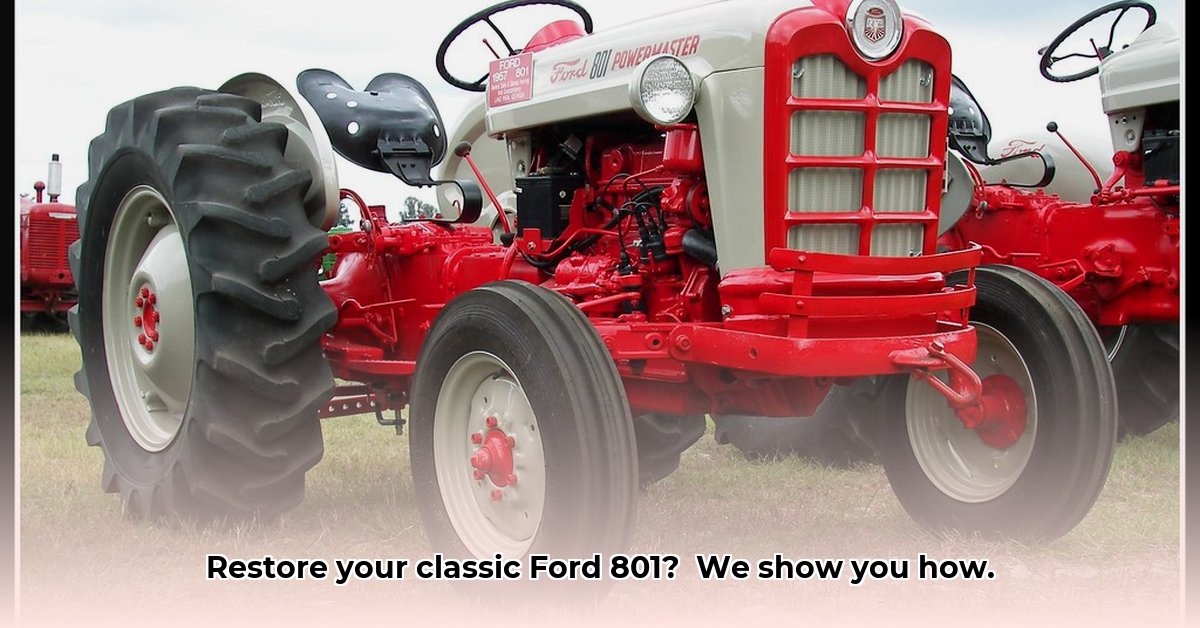
Ford 801 Tractor: A Timeless Workhorse
The Ford 801 Powermaster, produced from 1957 to 1962, represents a significant piece of agricultural history. Its robust design and versatile engine options—gasoline, liquid propane gas (LPG), and diesel—catered to a range of farming needs. Today, it's a coveted classic tractor, offering a rewarding restoration project for enthusiasts. Restoring an 801 isn't just about mechanics; it's about preserving a piece of history. For more Ford tractor models, see this helpful resource. Have you ever considered the satisfaction of bringing a piece of agricultural heritage back to life?
Decoding Your Ford 801's Engine: Power Under the Hood
The Ford 801 boasts a 2.8-liter engine. While horsepower claims vary slightly across sources, it generally delivers around 62-63 gross horsepower, consistent across gasoline, LPG, and diesel variants. Precise specifications depend on the year of manufacture; consult original owner's manuals or Ford's archives for exact figures.
| Engine Type | Fuel Type | Approximate Horsepower (Gross) | Notes |
|---|---|---|---|
| 2.8L | Gasoline | 62-63 | Widely available fuel; simpler system maintenance. |
| 2.8L | LPG | 62-63 | Fuel-efficient but requires specialized tanks. |
| 2.8L | Diesel | 62-63 | High torque, but potentially more complex maintenance. |
Remember, these are estimates. Actual horsepower varies based on engine condition and maintenance.
Conquering the Unsynchronized Transmission: A Skill-Building Challenge
The Ford 801's unsynchronized transmission is both its unique charm and its primary restoration challenge. Mastering the double-clutch technique is essential for smooth shifting. Expect some initial gear grinding—it's part of the learning curve!
Mastering the Double Clutch:
- Fully depress the clutch.
- Shift to neutral. Slowly release the clutch.
- Depress the clutch again. Briefly rev the engine to match the next gear's speed. Then, engage the next gear.
Practice ensures smooth, efficient shifting.
Sourcing Parts: The Treasure Hunt
Finding parts for a classic tractor can be challenging. Online forums, dedicated classic tractor parts suppliers, and networking with fellow enthusiasts are excellent resources. Reputable suppliers provide original or high-quality reproduction parts. Modern solutions like 3D printing can also prove valuable. What's your preferred method for sourcing rare parts?
Identifying Your Ford 801: Spotting the Subtle Differences
Precise identification is crucial for parts sourcing. Your tractor's serial number is key, revealing details about its specifications and modifications.
Navigating the Electrical System: 6V or 12V?
The electrical system is either 6V or 12V, depending on the year and engine type. Incorrect voltage can cause serious damage. Verify your system's voltage before working on the electrical components.
How to Restore a Ford 801 PowerMaster Transmission
The Ford 801/841 PowerMaster features three independent fluid systems: transmission, hydraulics, and rear axle, each requiring specific fluids and maintenance. The optimal transmission fluid – Universal Tractor Fluid (UTF) meeting Ford specification 134D or 80W-90 gear oil – is a frequent discussion point among enthusiasts, depending on tractor age and condition (and identifying any leaks). Accurate fluid capacities vary widely between sources; precise measurement prevents overfilling or underfilling. Regular fluid changes and careful inspections are essential.
Step-by-Step Transmission Restoration (Conceptual Guide)
- Disassembly: Methodically disassemble the transmission, meticulously documenting each step with photos for reassembly.
- Cleaning: Thoroughly clean components, removing old grease and inspecting for wear.
- Repair/Replacement: Replace worn parts (gears, bearings, seals). Professional assistance might be needed.
- Reassembly: Carefully reassemble, following your documented steps and tightening bolts correctly.
- Testing: Rigorously test the transmission's functionality.
This is a simplified overview; a complete guide is far more extensive. How do you plan to approach disassembly and documentation?
The Rewarding Journey of Restoration
Restoring a Ford 801 is more than just fixing a machine; it's a rewarding journey connecting you with agricultural history. The accomplishment of bringing this classic back to life is deeply satisfying. What aspect of this restoration process excites you the most?